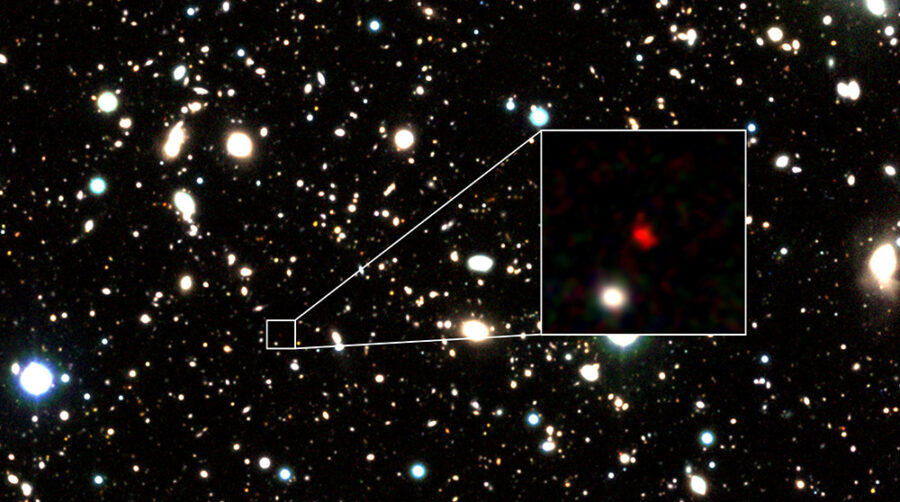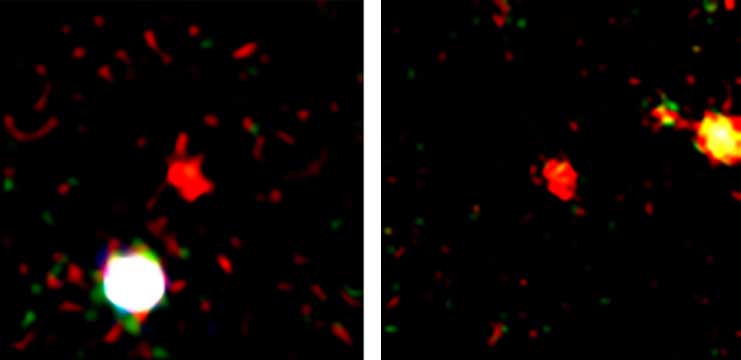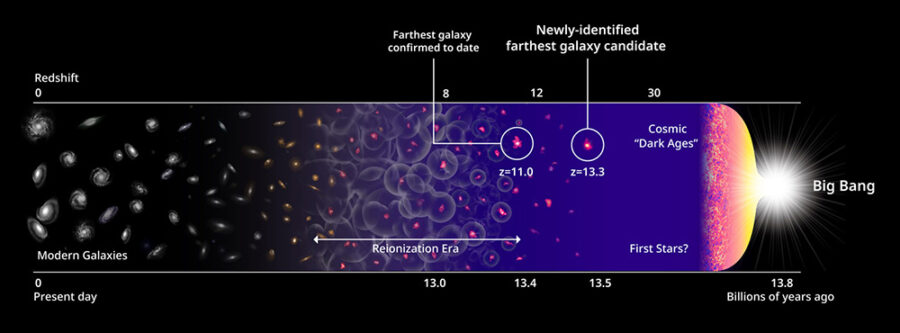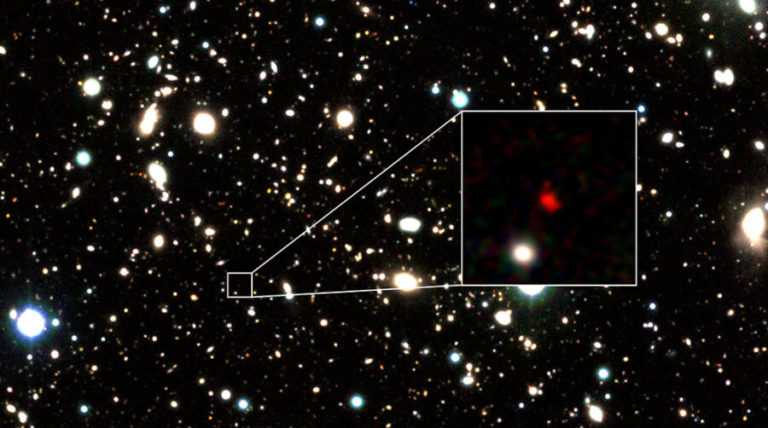Researchers find what might be the most distant galaxy yet
Two fuzzy red objects in the early universe may be galaxies shining at us from only a few hundred million years after the Big Bang.
Astronomers may have found the most distant galaxies ever seen. In two papers posted to the arXiv preprint server, Yuichi Harikane (University of Tokyo) and an international team report the detection of two sources that appear to blaze at us from a mere 330 million years after the Big Bang. In astronomers’ lingo, that corresponds to a redshift of 13. The studies have been submitted for publication but are not yet peer-reviewed.

Observers have previously found a handful of galaxies in the universe’s first few hundred million years. The current recordholder with a secure measurement is GN-z11, announced by Pascal Oesch (now at University of Geneva) and others in 2016. GN-z11’s redshift is about 11, meaning we see it as it was 420 million years after the origin of the observable universe. Other, less definitive finds suggest galaxies around this time had fairly mature stars, implying stars first lit up within the universe’s first 300 million years.
Even if the two new galaxies prove to lie as far away (and thus, as early) as they appear to, they likely are not from the population of first galaxies, Harikane says. Based on their brightness, the galaxies may contain at least 1 billion solar masses in stars — similar to the Magellanic Cloud dwarf galaxies, and too hefty to be the first generation. “We think that they evolved from smaller galaxies,” he says.

FINDING THE FIRST GALAXIES
The first galaxies set the cosmic stage. Their stars created heavier elements (such as carbon and oxygen) than the simplest atoms made in the primordial inferno, and their black holes grew to be the behemoths we see today in the hearts of nearly every massive galaxy.
These supermassive black holes present a mystery. Scientists have spotted them as far back as 1 billion years post–Big Bang, but those early examples are far larger than expected — easily a billion times the mass of the Sun. It’s hard to explain how such gargantuas came together within a measly billion years. Finding the first galaxies (and their black holes) and figuring out what they were like when they formed will help astronomers solve this conundrum.
With these points in mind, Harikane’s team went looking for early galaxies in archival images from a combination of ground- and space-based telescopes, covering visible and infrared wavelengths. They hunted for galaxies detected at the longest, reddest wavelengths but invisible at shorter ones. That’s because photons with short, blueward wavelengths (specifically, those shorter than 91.2 nanometers) are easily absorbed by neutral hydrogen, either within a galaxy or in clouds lying between us and it. This creates what’s called the Lyman break in a galaxy’s spectrum. As the universe expands, the galaxy becomes more distant and its light stretches to redder and redder wavelengths, and this spectral marker in its light shifts redward. The light that does make it to us from the galaxy is all redward of the break, telling us approximately how much the light has redshifted and thus how far back in cosmic time we’re looking.
After scouring the images with both computers and eyes, the team found two candidates, called HD1 and HD2. Astronomers actually already knew of HD1 but had cataloged it as a much closer galaxy.

The team next looked at HD1 with the ALMA radio telescope in Chile, to see if they could measure the object’s precise redshift, thereby confirming that the dropout technique had really turned up early galaxies. ALMA detected a hint of a strongly redshifted line from ionized oxygen. If real, then that ionized oxygen confirms that HD1 has a redshift of 13.27 — and bingo, we have the earliest galaxy yet seen. But if that spectral line is not what it seems, then HD1 and HD2 might lie more than a billion years later in cosmic history.
“These sources are very intriguing, but I am not yet 100% convinced about their extremely high-redshift nature,” Oesch says, lamenting the inconclusive ALMA detection.

SURPRISINGLY BRIGHT
The two galaxies are brighter than expected for normal star-forming galaxies, as are some other candidates found in this era, including GN-z11. In a companion paper to the one announcing the discovery, Fabio Pacucci (Center for Astrophysics, Harvard & Smithsonian), Harikane, and their colleagues consider possible reasons for the puzzling luminosities.
They suggest that a combination of rampant starbirth and a madly gobbling black hole might make both HD1 and HD2 surprisingly luminous. Prolific star formation or an overzealous black hole could each alone explain the radiation, but that’s a bit harder to accomplish.
If researchers confirm that HD1 and HD2 are early galaxies, then these objects might be telling us that star formation was more efficient in the early universe. They could also shed light (pun intended) on how the first supermassive black holes formed and grew.
But if they’re instead from a later cosmic era, then they would add to growing evidence that many galaxies have evaded detection because they’re shrouded in dust, which makes them too dim and red for, say, the Hubble Space Telescope to pick up.
“Whatever the nature of these sources turns out to be, they are interesting,” Oesch says.
Harikane and several collaborators have already secured time on the newly launched James Webb Space Telescope to take infrared spectra of HD1, HD2, and a third candidate. They estimate that JWST and other planned space telescopes could together discover more than 10,000 galaxies at this early epoch.
Do not forget to share your opinion with us to provide you with the best posts !





0 Comments